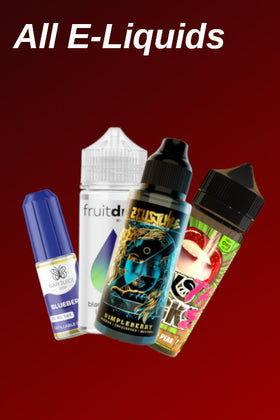
Guide to E-Liquids
Having a vape with no liquid is like having a car with an empty fuel tank.
Useless.
E-Liquids are a vital part of vaping, however, there's a lot to consider when picking the right liquid for you. We've put together this guide to help you navigate the world of vape liquid.
What Does PG & VG Mean?
PG & VG are food safe liquids that make the bulk of e-liquids. PG stands for Propylene Glycol and VG stands for Vegetable Glycerine. Almost all vape liquids contain a ratio of both ingredients, with some labelled as “Max VG” meaning they only contain a small amount of PG.
Continue to find out more about PG & VG and what the differences are between ratios for e-liquids.
Propylene Glycol or PG is commonly used in the food industry as a preservative. It is also used in the UK medical industry and can be found in asthma inhalers. It's a colourless liquid with a slightly sweet taste. Primarily used as a 'base' ingredient in vape juices, it has a lower viscosity than vegetable glycerine.
Vegetable Glycerine or VG is also a colourless liquid used in the food industry, mainly as a sweetener & thickener. Like PG, VG is also used as a base for e liquids, as well as acting as a sweetener. It can either be synthetic or derived from plants or animals. It has a thicker consistency than PG and therefore helps to produce a more dense vapour.
Ingredients In E-Liquids
There are three base e liquid ingredients that you'll tend to find in most vape juices.
These consist of:
- Propylene glycol (PG)
- Vegetable glycerine (VG)
- Flavourings
E-Liquids can also contain various strengths of nicotine, this ranges from nicotine free or 0mg all the way up to 20mg. 20mg is the highest legal strength of nicotine able to be sold in e-liquid as set out by the EU TPD Regulations. Pre-filled pod cartridges contain small amounts of e-liquid, up to 2ml, and are made up of the same ingredients as listed above.
Nicotine in E-Liquids
Nicotine is a stimulant substance which is considered to be highly addictive. It is a naturally occurring chemical found in the tobacco plant and can be found in small amounts in some fruit and vegetables. Many e-liquids are available as 0mg or nicotine free, however, people generally choose vape liquids containing nicotine as it helps with the transition from smoking to vaping.
Types of Nicotine
Freebase Nicotine
Freebase nicotine is the most common form of nicotine used in the majority of liquids and has been around for as long as vaping has. Unless a liquid explicitly states it contains nicotine salts, you can be sure it utilises freebase nicotine. It gives the user a stronger throat hit which some vapers consider to be a more satisfying hit, however, at higher nicotine strengths it can become harsh on the throat.
Nicotine Salts or 'Nic Salts'
Nicotine salts or “Nic Salts” are a newer form of organic nicotine, they provide a faster, smoother nicotine intake, there is little to no throat hit at lower strengths making them incredibly popular with vapers who don’t like the throat hit or for ex-smokers who, typically, struggle with the transition. They are an excellent option for people first making the switch to vaping from smoking as they allow higher nicotine strengths and provide faster craving satisfaction.
Find out more about freebase nicotine and nicotine salts.
What Does the PG/VG Ratio in E-Liquids Mean?
E-Liquids are mixed with different ratios of PG & VG. The different ratios of these two ingredients will alter certain aspects of the vaping experience such as, throat hit, strength of the flavour and the cloud production. They are most commonly displayed in percentages, the most common being 70/30, 80/20 or 50/50 (Always with VG first, followed by PG)
- A High PG liquid (Usually 60%+) will give a strong throat hit, with strong flavour and a low cloud production.
- An even split of VG & PG (50/50) Will give both a medium throat hit and medium flavour, with a medium cloud production.
- A High VG liquid (Usually 70%+) Will give a low throat hit with a medium flavour, with a high cloud production.
Which PG/VG Ratio Do I Need For My Vape Kit Or Tank?
We don’t recommend using a high VG e-liquid with any form of MTL Kit or Tank. VG has a much thicker consistency than PG and as such must be used at much higher wattages. Which MTL kits and tanks cannot reach, this will cause your coils to burn out much quicker.
Likewise, it is not recommended to use a high PG liquid in any sub-ohm or DTL kit as the thinner liquid can cause the device to leak and will give an almost unbearable throat hit at higher wattages, these liquids will also cause your coil to burn out much quicker.
Thankfully, at touchofvape.com we list the recommended ratio of e-liquid for every device in the product description so you can be sure you’re getting the correct juice for your device.


Leave a comment